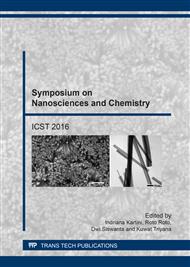p.32
p.37
p.44
p.50
p.55
p.65
p.69
p.79
p.85
Effect of Chemical Reduction Temperature on Optical Properties of Reduced Graphene Oxide (rGO) and its Potentials Supercapacitor Device
Abstract:
Reduced graphene oxide (rGO) has been successfully synthesized from graphite powder using Hummer’s Method. The epoxy group in GO structure was reduced by hydrazine 80 wt% at a temperature of 70o, 80o, and 90°C. The optical properties of produced rGO were characterized by using Uv-Vis and FTIR spectrometer. From Uv-Vis spectroscopy we observe that the absorbance of rGO decreased as increasing the reduction temperature. This is because the higher reduction temperature yields a high degree of rGO defect. The rGO produced at a reduction temperature of 70oC has very close similiraties absorbance spectrum with rGO produced by Sigma Aldrich Company. The Uv-Vis absorbance of rGO was used to calculated optical constant, and by using Kramers-Kronig relation we got refractive index values of rGO. The decreasing of absorbance may also stem out from the reducing of C=C bonding with sp2 hybridization due to the presence of energetic Hydrazine as indicated by the decrease of FTIR spectrum at ~1600 cm-1. Our produced rGO then used to fabricated the supercapacitor device with a mass of 0,03 gram using Polivinyl Alcohol (PVA) as a binder. From cyclic voltammetry measurement, we obtain the specific capacitance of our rGO-based supercapacitor is 2.45 F which is still in the category of supercapacitive although the optimization of rGO and PVA composition is still required. Our result shows the exciting potential of rGO based supercapacitor as electrical energy storage.
Info:
Periodical:
Pages:
55-61
Citation:
Online since:
July 2017
Authors:
Price:
Сopyright:
© 2017 Trans Tech Publications Ltd. All Rights Reserved
Share:
Citation:


